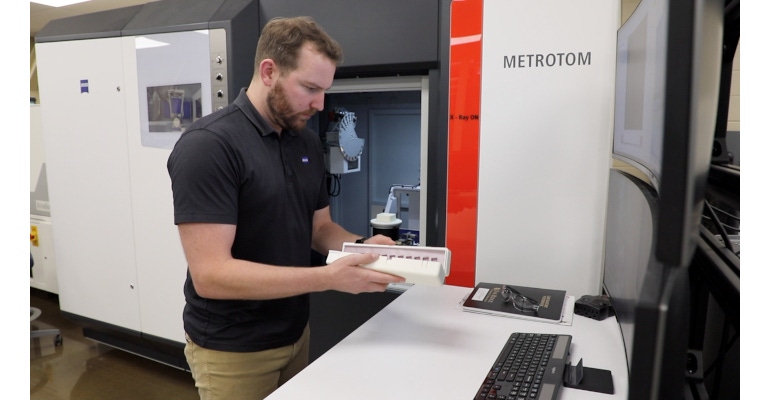Method for Verifying 3D-Printed Parts Aimed at Fostering Innovation
A streamlined deep-learning framework from the DoE could speed up inspection of 3D-printed parts.
January 4, 2023

A new framework developed by researchers at the Department of Energy (DoE) is expected to help evolve the innovation of 3D-printed metal parts by providing a faster and more efficient way to verify their accuracy for industrial manufacturing, researchers said. A team at the DoE's Oak Ridge National Laboratory (ORNL) is using X-ray computed tomography (CT) to inspect metal parts being fabricated using additive manufacturing (AM) to ensure they are being produced according to desired specifications, researchers said. The method dramatically can reduce the time and costs currently incurred for the labor-intensive yet extremely helpful inspection process, which typically takes weeks, they said.
This faster and more efficient way to verify the accuracy of metal parts for production environments can help remove cost, quality-control, and other barriers that using AM to manufacture metal parts in industrial processes currently face, researchers said.
“With this, we can inspect every single part coming out of 3D-printing machines,” said Pradeep Bhattad, business development manager for AM at ZEISS, an international optics engineering company and DoE business partner that's already using the deep-learning framework in its software. “Currently CT is limited to prototyping. But this one tool can propel additive manufacturing toward industrialization.”
The technology can be applied to parts being printed for many fields, including defense, auto manufacturing, aerospace, and electronics printing, as well as nondestructive evaluation of electric vehicle batteries, researchers said.
Benefits of the Framework
Metal 3D-printing has yet to fulfill its full promise to streamline the way metal parts are manufactured because of limitations that exist in the process, one of which is how to quickly and effectively ensure that parts are accurately built for their intended purpose. Researchers have been working on numerous ways to find solutions, one of which is X-ray CT scanning, which is a key way to certify the soundness of a 3D-printed part without damaging it.
The process is similar to medical X-ray CT in that an object is slowly rotated and scanned at each angle by strong X-rays. Then, computer algorithms use the resulting 2D projections to create a 3D image that shows the density of the object’s internal structure in a way that can detect defects, analyze failures, or certify that a product matches the intended composition and quality.
While X-ray CT has many benefits for metal-part verification, it's not currently used in large-scale AM because current methods to scan and analyze parts are time-intensive and imprecise, researchers said.
That could change, however, thanks to the deep-learning framework produced by an ORNL team led by lead researcher Amir Ziabari. The framework tweaks how the process is typically done to save time and thus expensive resources, as well as provides a clearer, more accurate reconstruction and automated analysis of the part, he said.
“The scan speed reduces costs significantly,” Ziabari said in a press statement. “And the quality is higher, so the post-processing analysis becomes much simpler.”
To train a supervised deep-learning network for CT typically requires numerous expensive measurements and can be difficult to attain, especially for metal parts. However, the approach of Ziabari’s team evolves the process by generating realistic training data without requiring extensive experiments to gather it, he said.
The framework uses what's called a generative adversarial network (GAN) method to create a realistic-looking data set synthetically that can train a neural network, Ziabari said. GAN is a class of machine learning in which neural networks compete with each other like they're in a game; however, the method rarely has been used in such a practical application, he said.
Fostering Innovation
The GAN method used in the team's framework uses physics-based simulations and computer-aided design in such a way that the CT scans require fewer angles of the part to achieve accuracy, researchers said. This serves to reduce imaging time from about one hour to 10 minutes or less—which is by a factor of six, Ziabari said.
While typically working that quickly with this number of viewing angles would add significant “noise” to the 3D image, the ORNL algorithm that was taught on the training data corrects this phenomenon, he said. In fact, it can even enhance small flaw detection by a factor of four or more, Ziabari said.
The speed and accuracy with which the technology works allows manufacturers to rapidly fine-tune 3D-printed metal parts, even while changing designs or materials, researchers said. This can help them reduce the time it takes to conduct verification using CT scanning from six-to-eight weeks to one day, they said.
“If I can very rapidly inspect the whole part in a very cost-effective way, then we have 100% confidence,” Bhattad said.
Researchers posted a video on YouTube about their deep-learning framework and its benefits to 3D-printed metal-part verification.
The ORNL team printed hundreds of sample parts using various scan parameters and complicated, dense materials to test the performance of their framework. The results of these tests were promising, and they continue to conduct trials in ORNL's Manufacturing Demonstration Facility to verify that the technique is effective no matter what type of metal alloy is used, Bhattad said.
This aspect is important to the broader impact of the framework, as it could help accelerate the use of novel metal alloys in AM if it's easier and faster to verify parts made using them, and thus foster innovation in the field more quickly, Ziabari said.
“People don’t use novel materials because they don’t know the best printing parameters,” he said in a press statement. “Now, if you can characterize these materials so quickly and optimize the parameters, that would help move these novel materials into additive manufacturing.”
About the Author(s)
You May Also Like
.jpg?width=300&auto=webp&quality=80&disable=upscale)


